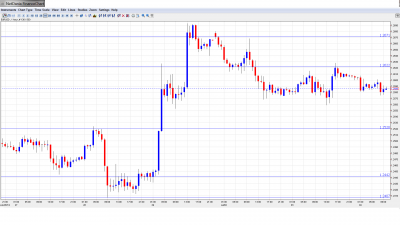EUR/USD remained steady, as the markets are in a holding pattern prior to the ECB meeting on Thursday. The central bank is widely expected to lower interests rates from the present 1.0% level. Last week’s euphoria has quickly given way to market uncertainty as to whether the new measures outlined at the European Summit will resolve the crippling debt crisis. The markets are also waiting for key US employment data on Friday, including Non-Farm Payrolls and the Unemployment Rate. There was some good news as Euro-zone Retail Sales posted a 0.6% gain, well above the market forecast. In the US, the markets are closed on Wednesday for the Fourth of July holiday.
Here’s an update on technicals, fundamentals and what’s going on in the markets.
EUR/USD Technicals
- Asian session: Euro/dollar was quiet, reaching a high of 1.2995, and consolidating at 1.2582. The pair is unchanged in the European session.
- Current range: 1.2520 to 1.2624.
- Further levels in both directions:
- Below: 1.2520, 1.2440, 1.24, 1.2330, 1.2288, and 1.22.
- Above: 1.2624, 1.2670, 1.2760, 1.2814 and 1.2873, 1.29 and 1.2960.
- Yet again, the January 2012 low of 1.2624 proved to be strong in both directions. It is currently providing weak resistance, as the pair trades in a narrow range.
- 1.2520 is providing the pair with strong support.
Euro/Dollar steady in quiet trading – click on the graph to enlarge.
EUR/USD Fundamentals
- 7:45 Italian Services PMI. Exp. 42.6 points. Actual 43.1 points.
- 8:00 Euro-zone Final Services PMI. Exp. 46.8 points. Actual 47.1 points.
- 9:00 Euro-zone Retail Sales Exp. +0.3%. Actual +0.6%.
- 9:00 Euro-zone Final GDP Exp. 0.0%.
For more events and lines, see the Euro to dollar forecast
EUR/USD Sentiment
- Will ECB lower interest rates:? The markets are expecting the ECB to cut interest rates on Thursday from the present 1.0%. Most analysts are predicting a 0.25% drop, but there are some who are forecasting a 0.50% cut. ECB chief Mario Dragahi is under pressure to take action to help stimulate and stabilize the EZ, and lower interest rates would help improve economic activity and boost exports.
- Euro rally stalls following summit euphoria: After the EU Summit announced a series of measures to deal with the debt crisis in the Euro-zone, the euro jumped by about 2% against the dollar. At the Summit, leaders agreed that the ESM will NOT have seniority over private bondholders. This will help in calming investors. Other than that, they decided on allowing the ESM bailout fund to recapitalize banks and buy bonds, but the statement is quite ambiguous. The good news for the weaker zone members is that bailout funds can now be distributed directly to banks that need help, without adding to the national debt. There are at least 5 holes in the EU Summit statement, so the rally we saw on Friday could falter later on. Cracks are already apparent in the EU announcement, as the Netherlands and Finland want to block ESM bond buying. As well, German Chancellor Merkel is facing heavy criticism for caving in at the Summit and will face a tough time selling the deal to skeptical German lawmakers.
- US data disappoints: US Manufacturing PMI was very disappointing, as the key index contracted for the first time in three years. The markets will be carefully watching the Non-Farm Employment Change and Unemployment Rate releases on Friday. If these figures fall below the market forecasts, this could be further indication of a US economy in trouble, and we could see the dollar drop as a result.
- German economy showing weakness: The drop in retail sales joins earlier disappointments and shows that Germany is not immune. Last week’s saw a disastrous German ZEW Economic Sentiment and a rise in unemployment. With the Euro-zone in deep trouble, a sputtering German economy will throw a big wrench into any recovery plans.
- Spain’s trouble continue: Spanish yields continue falling after Friday’s big move and this supports the euro.There are still some uncertainties and at least 8 holes in the aid package. More details about the bailout are expected on July 9th. The Spanish government is feeling the heat, and recently passed a new law limiting cash transactions. Meanwhile, Spain’s weak housing sector received more bad news, as house prices declined by 2.8% in Q2. About the only thing Spaniards have had to cheer about lately is Spain winning the Euro 2012 soccer tournament.
- Will Fed take action?: In June, the Fed decided not to introduce QE, but did announce that it would extend Operation Twist. However, with a host of weak data, most recently Manufacturing PMI, QE3 cannot be discounted. If this week’s US employment data is weak, pressure on the Federal Reserve to take action will increase. Meanwhile, speculation is growing that the Fed will step in and implement QE to help the US economy.

